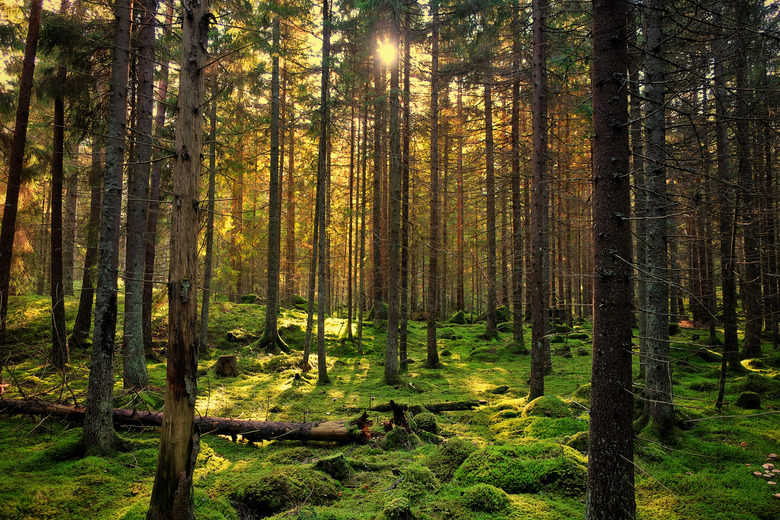A List Of North Carolina's Natural Resources
North Carolina is some 560 miles wide and is unusually diverse from a geographical and geological standpoint, which gives the "Tar Heel State" a variety of living and nonliving natural resources. This southeastern state includes three distinct landforms: a coastal plain to the east, the Piedmont in the interior, and the Appalachian Mountains to the west. Each contributes its share to North Carolina's natural bounty.
Stunning Forests
Stunning Forests
North Carolina is home to millions of acres of forests, and forest products make up the state's largest manufacturing industry. Forests also play a large part in the state's tourism and recreation sector, notably through four national forests – Nantahala, Pisgah, Uwharrie and Croatan – encompassing 1.25 million acres. As of 2014, these retreats drew approximately 7 million visitors a year. Nantahala, the largest, ranges in elevation from 1,200 to 5,800 feet. Pisgah, the next largest, is known for its waterfalls and especially rich forests. Uwharrie, though small at about 50,000 acres, provides plenty of recreation opportunities and sparkling-clean rivers and streams. Croatan is the wettest of the quartet, and opportunities for canoeing and fishing abound on its many bogs and marshes. Also, Great Smoky Mountain National Park, which straddles eastern Tennessee and western North Carolina, is the most-visited national park in the U.S. and is open 24 hours a day, 365 days a year.
A Wealth of Minerals
A Wealth of Minerals
Minerals – compounds or elements of unique crystal structures and physical properties such as hardness and color – are deeply interwoven with North Carolina's very history: In 1823, the state became the first to commission a geological and mineralogical survey. As of 2014, North Carolina led the U.S. in the production of the popular minerals feldspar, mica and pyrophyllite. The largest-ever emerald crystal unearthed in North America was found in the Tar Heel State. Hunters of precious stones can look for rubies, garnets and more than 300 additional kinds of gemstones here.
Natural Diversity
Natural Diversity
They're not commonly thought of as a natural resource in the same way as logs or minerals, but North Carolina's varied geography and the natural diversity it creates are significant to the state's economy and quality of life. Its uplands and lowlands, forests and estuaries serve as a draw for tourists and their dollars, a recreational escape for locals, and a range of varied habitats for wildlife. Hunters, birdwatchers and outdoor enthusiasts can find all manner of wildlife scattered across the state's biomes. These include big game animals such as black bears and deer, game birds such as wild turkeys and pheasants, and plenty of migratory birds and waterfowl.
Coasts, Waterways and Aquatic Life
Coasts, Waterways and Aquatic Life
North Carolina's ample coastline and inland waterways, along with the aquatic life they support, constitute another significant natural resource. Recreational properties and resorts on these many waterways help fill the state's coffers, and so do the 25,000 or so licenses issued each year in the commercial and sport fisheries. The two deep water seaports of Wilmington and Morehead City also stand out as important natural resources, capable of handling high volumes of freight traffic. North Carolina's central location on the Atlantic Coast makes the two ports especially attractive, providing short shipping routes to major centers across the eastern third of the country.
Cite This Article
MLA
Crystal, Mike. "A List Of North Carolina's Natural Resources" sciencing.com, https://www.sciencing.com/list-north-carolinas-natural-resources-7454040/. 13 March 2018.
APA
Crystal, Mike. (2018, March 13). A List Of North Carolina's Natural Resources. sciencing.com. Retrieved from https://www.sciencing.com/list-north-carolinas-natural-resources-7454040/
Chicago
Crystal, Mike. A List Of North Carolina's Natural Resources last modified March 24, 2022. https://www.sciencing.com/list-north-carolinas-natural-resources-7454040/
